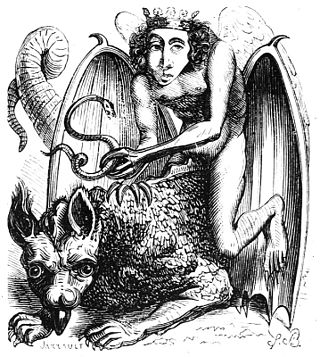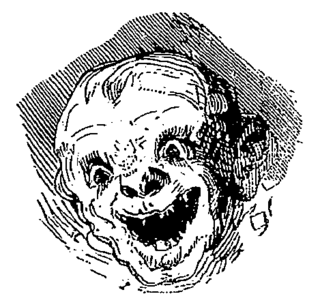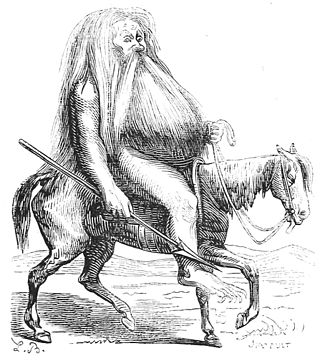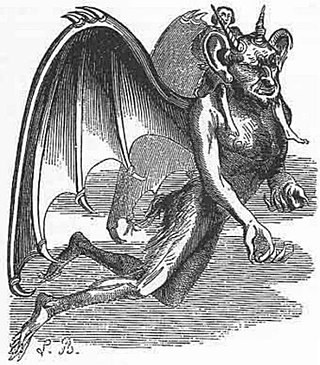
Astaroth, in demonology, is known to be the Great Duke of Hell in the first hierarchy with Beelzebub and Lucifer; he is part of the evil trinity. He is known to be a male figure, most likely named after the unrelated Near Eastern goddess Astarte.

Aamon, in demonology, is a Grand Marquis of Hell who governs 40 infernal legions, and the 7th spirit of the Goetia. He is the demon of life and reproduction.

Bael is a demon described in demonological grimoires such as The Lesser Key of Solomon and the Pseudomonarchia Daemonum and also in the Dictionnaire Infernal. He is described as a hoarsely-voiced king with the power to make men invisible and ruling over sixty-six legions of demons. The Lesser Key of Solomon describes him as appearing in the form of a cat, toad, human, some combination thereof, or other "diverse shapes", while the Pseudomonarchia Daemonum and the Dictionnaire Infernal state that he appears with the heads of a cat, toad, and human simultaneously.

Alloces is a demon that appears in demonological grimoires such as the Liber Officiorum Spirituum, Pseudomonarchia Daemonum, and the Lesser Key of Solomon. He is described in the Lesser Key of Solomon and in the Pseudomonarchia Daemonum as a duke, taking the form of a fire-breathing, lion-headed soldier riding a horse. His purported duties include teaching astronomy, and liberal sciences, and granting familiars. He is claimed to have 36 legions of demons under his command. In the Liber Officiorum Spirituum, Alloces appears as Allogor or Algor, again a duke, but otherwise with a completely different appearance and abilities -- a spear-toting knight who answers questions, provides advice for plans, and commands only 30 legions of demons. In the duplicate entry, Alloces appears as Algor, ruled by the spirit "Orience" (Oriens), again as a knight who explains secrets, but with the additional power of garnering the favor of nobles. According to Rudd, Alloces is opposed by the Shemhamphorasch angel Imamiah.
Vine is a demon listed in demonological grimoires such the Lesser Key of Solomon Johann Weyer's Pseudomonarchia Daemonum, and Jacques Collin de Plancy's Dictionnaire Infernal.

Bifrons is a demon described in the demonological grimoires the Lesser Key of Solomon and the Pseudomonarchia Daemonum, as well as being mentioned in the Dictionnaire Infernal. These works describe Bifrons as an earl who initially appears as a monster before adopting a more human form. His duties include teaching arts and sciences, including astrology, geometry, and the properties of different plants and stones. He also moves bodies into different graves, lights candles over graves, and commands either 6, 26, or 60 legions of spirits.
The Lesser Key of Solomon, also known by its Latin title Lemegeton Clavicula Salomonis or simply the Lemegeton, is an anonymously authored grimoire on sorcery, mysticism and magic. It was compiled in the mid-17th century, mostly from materials several centuries older. It is divided into five books: the Ars Goetia, Ars Theurgia-Goetia, Ars Paulina, Ars Almadel, and Ars Notoria. It is based on the Testament of Solomon and the ring mentioned within it that he used to seal demons.
In demonology, Amaymon is a prince of Hell, and, according to some grimoires, the only one who has power over Asmodai.
The Pseudomonarchia Daemonum first appears as an appendix to De praestigiis daemonum (1577) by Johann Weyer. An abridgment of a grimoire similar in nature to the Ars Goetia, it contains a list of demons, and the appropriate hours and rituals to conjure them.
Bune is a demon listed in demonological grimoires such the Lesser Key of Solomon Johann Weyer's Pseudomonarchia Daemonum, Jacques Collin de Plancy's Dictionnaire Infernal, and the Livre des Esperitz.
Gamigin is a demon described in demonological grimoires such as The Lesser Key of Solomon and Johann Weyer's Pseudomonarchia Daemonum.

Lerajie is a mighty Great Marquis of Hell who has thirty-three legions of Demons under his power. He is said to cause great battles and disputes, and makes gangrene wounds caused by arrows. He can make a lover come to him, and also send them away. He is depicted as a gallant and handsome archer clad in green, carrying a bow and quiver, in the folklore of the Bible. But his true appearance is around 5 feet tall, with shoulder length black hair and bangs. With a long shimmering red wingspan. Leraje is a demon mentioned in demonological grimoires. He appears in the Lesser Key of Solomon, Johann Weyer's Pseudomonarchia Daemonum, and Jacques Collin de Plancy's Dictionnaire Infernal.
Botis, sometimes Otis, is a demon described in the Lesser Key of Solomon and the Pseudomonarchia Daemonum as a President and an Earl who initially appears as a viper before changing into a sword-toting, fanged, and horned human who discusses matters past, present, and future; brings favor from allies and enemies, and rules 60 legions of demons. In the Munich Manual of Demonic Magic, Botis appears as Otius, and is mostly identical except that he is a preses and Count, appears in the more humanoid form to begin with, and rules only 36 legions of demons. In the Grand Grimoire, Botis appears as a subordinate of Agaliarept. According to Rudd, Botis is opposed by the Shemhamphorasch angel Lauviah.
In demonology, Morax, also spelled Foraii, Marax, or Farax, is a Demon, Great Earl, and President of Hell, having thirty legions of demons under his command. He teaches astronomy and all other liberal sciences, and gives good and wise familiars that know the virtues of all herbs and precious stones.

In demonology, Furcas is a Knight of Hell, and rules 20 legions of demons. He teaches Philosophy, Astronomy, Rhetoric, Logic, Chiromancy and Pyromancy.

Gaap is a demon that is described in demonological grimoires such as the Lesser Key of Solomon, Johann Weyer's Pseudomonarchia Daemonum, and the Munich Manual of Demonic Magic, as well as Jacques Collin de Plancy's Dictionnaire Infernal,

Gemory is a demon listed in demonological grimoires.

Valac is a demon described in the goetic grimoires The Lesser Key of Solomon, Johann Weyer's Pseudomonarchia Daemonum, the Liber Officiorum Spirituum, and in the Munich Manual of Demonic Magic as an angelically winged boy riding a two-headed dragon, attributed with the power of finding treasures.
Amy is a demon described in demonological grimoires such as the Lesser Key of Solomon, the Pseudomonarchia Daemonum, and in the Munich Manual of Demonic Magic; as well as Jacques Collin de Plancy Dictionnaire Infernal,











